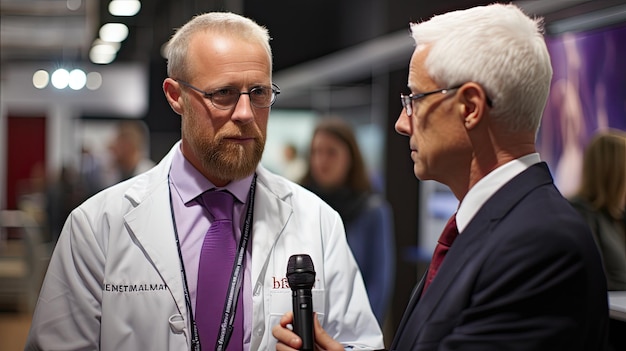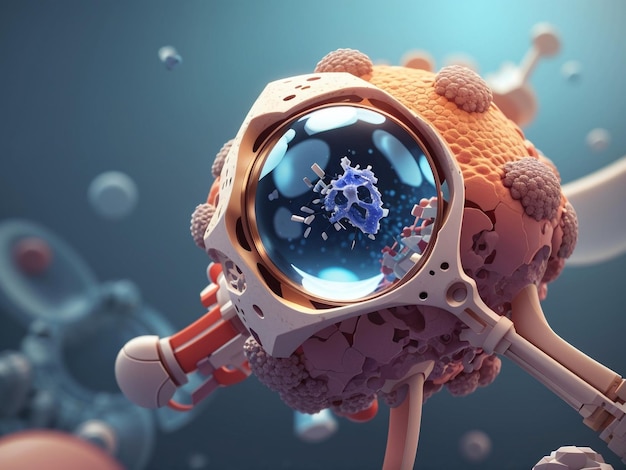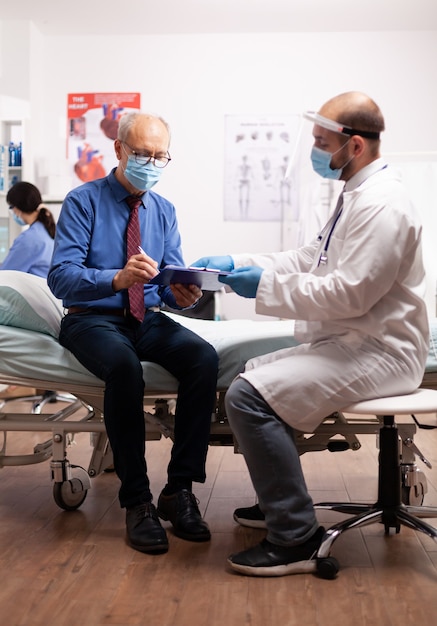Quick Read
Prostate Cancer: With Prevention and Early Detection, 91% of Patients Survive Five Years After Diagnosis
Prostate cancer, one of the most common
cancers
in men, has seen significant progress in recent years. The Rome Conference on July 16 provided valuable insights into the current state of prostate cancer research and treatment. According to the American Cancer Society,
91%
of patients diagnosed with prostate cancer survive for at least five years after diagnosis. This is a testament to the importance of prevention and early detection.
The Rome Conference emphasized the need for
risk assessment
and
prevention strategies
. Lifestyle factors such as a healthy diet, regular exercise, and avoiding smoking can help reduce the risk of developing prostate cancer. Additionally, regular
screening
using the Prostate-Specific Antigen (PSA) test and digital rectal examinations can help detect prostate cancer at an early stage, when it is most treatable.
Despite the progress, there are still challenges to overcome.
Overdiagnosis
and
overtreatment
of low-risk prostate cancers remain concerns, as they can lead to unnecessary side effects and costs. The conference highlighted the need for improved risk stratification tools to help identify which patients truly need treatment, and which can be monitored with active surveillance instead.
One of the most promising developments in prostate cancer research is the use of
precision medicine
. By analyzing a patient’s genetic makeup and tumor characteristics, doctors can tailor treatment plans to individual patients, increasing the chances of success while minimizing side effects. This approach was a major focus of the Rome Conference, and is expected to revolutionize the way prostate cancer is diagnosed and treated in the future.
In conclusion, the Rome Conference on July 16 underscored the importance of prevention and early detection in prostate cancer. With the right strategies, 91% of patients can survive for at least five years after diagnosis. However, there are still challenges to overcome, and ongoing research is essential to improve risk stratification, reduce overtreatment, and unlock the potential of precision medicine.

I. Introduction
Prostate cancer is a significant health concern for men worldwide, ranking as the second most common cancer in men globally. This disease affects millions of lives each year, with its prevalence continuing to rise due to aging populations and the adoption of Western lifestyles. The importance of raising awareness about prevention and early detection cannot be overstated, as early intervention significantly increases the chances of successful treatment and recovery.
Description of Prostate Cancer
Prostate cancer develops when normal cells in the prostate gland begin to grow uncontrollably and form a tumor. The prostate is a small gland located below the bladder and in front of the rectum, responsible for producing seminal fluid that nourishes and transports sperm. The initial growth of these cancerous cells may remain asymptomatic, but as the tumor advances, it can lead to various complications, including difficulties in urination, sexual dysfunction, and bone pain.
Importance of Awareness and Research
Given the potential seriousness of prostate cancer, it is essential that we continue to invest in research aimed at improving our understanding of this disease and developing effective prevention strategies. This summer, the global scientific community will gather in Rome, Italy, on July 16 for a landmark conference dedicated to advancing research and promoting new approaches to prostate cancer prevention.
Upcoming Conference in Rome
This conference, titled “International Symposium on Prostate Cancer: Prevention and Early Detection,” is an exceptional opportunity for researchers, clinicians, policymakers, and advocacy groups to exchange ideas, collaborate on new projects, and discuss the latest findings in prostate cancer prevention research. By fostering an open and inclusive dialogue among experts from diverse disciplines, this event seeks to pave the way for groundbreaking advancements in our ability to prevent and detect prostate cancer early – ultimately saving countless lives.
Stay Informed
As we continue to learn more about prostate cancer and its potential prevention, it is crucial that individuals take an active role in their own health. Stay informed about the latest research, maintain a healthy lifestyle, and be vigilant about potential symptoms or risk factors. Together, we can make a difference in the fight against prostate cancer.

Background: Understanding Prostate Cancer
Prostate cancer is a serious health concern for men worldwide. In this section, we will delve into the background of prostate cancer, starting with a basic understanding of the prostate gland and its function in the male body.
Description of the Prostate Gland and Its Function
The prostate gland
walnut-shaped
organ located just below the bladder and in front of the rectum. It encircles part of the urethra, the tube that carries urine and semen out of the body. Its main function is to produce most of the seminal fluid that is mixed with sperm from the testicles to form semen during ejaculation.
Explanation of Prostate Cancer Development and Risk Factors
Prostate cancer
begin to grow uncontrollably
. Over time, these abnormal cells can form a tumor that can invade nearby tissue and potentially spread to other parts of the body.
Genetic Predisposition
Research suggests that genetics play a role in prostate cancer development. Men who have a close family member (father, brother, or son) diagnosed with the disease are at an increased risk of developing prostate cancer themselves.
Age, Diet, Lifestyle, and Environmental Factors
Other risk factors for prostate cancer include: age (as men over 50 are more likely to develop the disease); diet, particularly diets high in red meat, dairy products, or saturated fats; lifestyle factors, such as physical inactivity and smoking; and environmental factors, including exposure to certain industrial chemicals or radiation therapy for other cancers.
Statistics on Prostate Cancer Incidence and Mortality Rates
According to the World Cancer Research Fund International, prostate cancer is the most commonly diagnosed cancer in men worldwide, with an estimated 1.4 million new cases and 358,000 deaths in 2020. In the United States alone, it is estimated that over 174,650 new cases and 33,330 deaths will occur in 2021.
Global Trends
Despite the high incidence and mortality rates, prostate cancer is more common in developed countries, with North America and Europe having the highest rates of new cases and deaths. In contrast, Africa has the lowest incidence and mortality rates.
Significance of Early Detection and Prevention
Early detection and prevention
Conclusion
In conclusion, understanding the background of prostate cancer is essential for both men and healthcare professionals. Knowing the normal function of the prostate gland, the risk factors for developing prostate cancer, and the importance of early detection and prevention can help raise awareness about this disease and encourage men to take steps to protect their health.

I The Power of Prevention: Strategies for Prostate Cancer Survival
Importance of lifestyle modifications for prostate cancer prevention
Lifestyle modifications play a crucial role in prostate cancer prevention. Adopting certain dietary habits, engaging in regular physical activity, and avoiding tobacco and limiting alcohol consumption are some of the effective strategies to reduce the risk of prostate cancer.
Dietary changes: Focus on fruits, vegetables, and whole grains
A diet rich in fruits, vegetables, and whole grains is essential for prostate health. These foods are high in fiber, vitamins, minerals, and antioxidants that help prevent cell damage and inflammation.
Regular physical activity
Engaging in regular physical activity for at least 30 minutes a day, five days a week can help reduce the risk of developing prostate cancer. Exercise not only keeps your body fit but also helps maintain a healthy weight and boosts your immune system.
Avoiding tobacco and limiting alcohol consumption
Avoiding tobacco use and limiting alcohol consumption are essential for prostate cancer prevention. Tobacco smoking increases the risk of developing prostate cancer, while excessive alcohol consumption can lead to various health issues, including an increased risk of this disease.
Role of regular screenings in prostate cancer prevention and early detection
Early detection is crucial for effective prostate cancer treatment. Regular screenings play a vital role in prostate cancer prevention and early detection.
Discussion on PSA (Prostate-Specific Antigen) testing
One of the most common screening methods for prostate cancer is PSA (Prostate-Specific Antigen) testing. PSA is a protein produced by the prostate gland, and elevated levels in the blood could indicate the presence of cancerous cells. However, it’s essential to note that PSA testing is not a perfect diagnostic tool and can lead to false positives or false negatives.
Pros and cons of different screening methods
There are other screening methods like digital rectal exams (DRE) and MRI (Magnetic Resonance Imaging). Each method has its pros and cons, making it essential to consult a healthcare professional for the most suitable screening option based on individual risk factors.
Importance of ongoing research and advancements in prostate cancer prevention and treatment
Ongoing research is crucial for understanding the causes of prostate cancer and developing new, effective prevention and treatment methods.
Update on latest studies and findings
Recent studies suggest that certain nutraceuticals and natural compounds, such as green tea polyphenols, lycopene, selenium, and vitamin E, may have protective effects against prostate cancer. These compounds are under investigation for their potential role in preventing and treating this disease.
Potential role of nutraceuticals and natural compounds in prostate cancer prevention
While more research is needed to confirm their effectiveness, these nutraceuticals and natural compounds show promising results in reducing the risk of developing prostate cancer. Incorporating them into your diet as part of a holistic prevention strategy could be beneficial for maintaining prostate health.

The Rome Conference: A Platform for Collaboration and Progress
Background on the conference, its organizers, and objectives
The Rome Conference is an international event bringing together renowned researchers, policy makers, advocacy groups, and healthcare professionals to discuss the latest advancements in prostate cancer prevention, treatment, and policies. The conference is organized by the European Association of Urology (EAU), the largest European professional organization in urology, and the American Society of Clinical Oncology (ASCO). The primary objective of this collaboration is to foster international cooperation in addressing prostate cancer as a global health concern.
Keynote speakers and their areas of expertise
The conference features keynote speakers from various fields, including:
- Renowned researchers in prostate cancer prevention and treatment:
Prof. Dr. Maria Rosaria Sansalone from the University of Naples Federico II in Italy, Prof. Dr. Manjit Bains from the University of Toronto in Canada, and Prof. Dr. Mark Emberton from UCL Hospitals NHS Foundation Trust in the United Kingdom are just a few of the distinguished experts addressing the latest research findings and their potential implications.
- Policy makers, advocacy groups, and healthcare professionals:
Representatives from the World Health Organization (WHO), European Commission, European Cancer Leagues, and various patient advocacy groups will discuss current policies and future directions to improve access to prevention, screening, and treatment.
Agenda and expected outcomes of the conference
The three-day conference includes presentations on prostate cancer‘s latest research findings, as well as panel discussions and workshops. Some of the key topics include:
- Prevention strategies:
Identifying modifiable risk factors, improving public awareness, and discussing the role of lifestyle choices in preventing prostate cancer.
- Current treatments:
Updates on surgical, radiation, hormonal, and emerging targeted therapies, as well as their effectiveness, side effects, and quality of life implications.
- Future directions:
Discussing personalized treatment approaches based on individual tumor characteristics, the role of artificial intelligence in prostate cancer diagnosis and treatment, and potential collaborations between academia, industry, and government to accelerate progress.
Importance of international collaborations in addressing prostate cancer as a global health concern
International collaborations are essential for sharing best practices and resources to combat disparities in access to prevention, screening, and treatment across countries. By learning from each other’s experiences, researchers, policymakers, and healthcare professionals can work together to develop more effective strategies for addressing this global health concern.
E. Expected impact of the conference on future research and policy initiatives
The Rome Conference is expected to yield several positive outcomes, including:
- New partnerships and funding opportunities:
Collaborations between researchers, policy makers, and patient advocacy groups could lead to new research initiatives, funding opportunities, and improved coordination among stakeholders.
- Advancements in understanding the underlying mechanisms of prostate cancer development and progression:
Insights from presentations and discussions may contribute to a better understanding of the underlying mechanisms of prostate cancer development and progression, enabling the development of more effective prevention and treatment strategies.

Conclusion: The Promise of a Proactive Approach to Prostate Cancer
Recap of the importance of prevention and early detection in prostate cancer survival
Prostate cancer is one of the most common types of cancer among men worldwide. According to statistics, five-year survival rates for patients with early detection are significantly higher than those diagnosed late. About 98% of men with localized prostate cancer survive beyond five years, compared to just 30% for those diagnosed when the disease has metastasized. Therefore, it is crucial that men prioritize prevention and early detection to improve their chances of survival.
Call to action: Encouraging men, especially those at higher risk, to prioritize prostate cancer prevention and regular screenings
Given these statistics, it is essential that men take preventative measures against prostate cancer. This includes maintaining a healthy lifestyle, such as eating a balanced diet, exercising regularly, and avoiding tobacco and excessive alcohol consumption. Men at higher risk, including those with a family history of prostate cancer or certain genetic mutations, should consider regular screenings, such as the Prostate-Specific Antigen (PSA) test. By taking these steps, we can significantly reduce the number of prostate cancer diagnoses and deaths each year.
Reflection on the Rome Conference as a significant step forward in addressing this global health issue
The Rome Conference on Prostate Cancer: Uniting for a Cure
was a significant event in the ongoing fight against prostate cancer. This conference brought together researchers, healthcare professionals, policymakers, and advocacy groups to promote collaboration and knowledge-sharing in the field. By fostering a global dialogue on this critical health issue, we can encourage ongoing investment in research to improve prevention strategies, treatments, and patient outcomes.
Promoting collaboration and knowledge-sharing among researchers, healthcare professionals, policymakers, and advocacy groups
The Rome Conference provided a platform for experts to share their latest findings and insights on prostate cancer research. By pooling resources and expertise, we can accelerate the development of new treatments and prevention strategies. Moreover, by engaging policymakers and advocacy groups in the conversation, we can ensure that these advancements are implemented effectively and accessible to those who need them most.
Encouraging ongoing investment in research to improve prevention strategies, treatments, and patient outcomes
The Rome Conference underscored the importance of continued investment in prostate cancer research. By funding new studies and clinical trials, we can uncover innovative approaches to preventing and treating this disease. Furthermore, by increasing awareness of the importance of prevention and early detection, we can reduce the number of new diagnoses each year and ultimately save lives.




